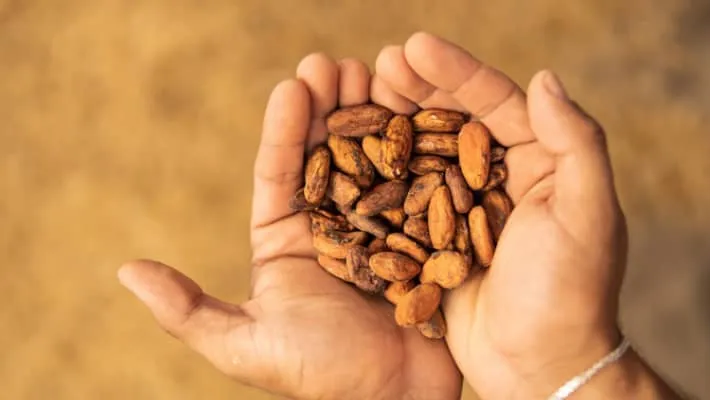Wednesday Nov 22 2023 14:17

10 min

The world's love affair with chocolate dates back centuries, but few give thought to the raw material that makes it possible: cocoa.
As a significant global commodity, cocoa fuels a multibillion-dollar industry and supports millions of livelihoods.
This article will delve into the intriguing world of cocoa trading, from understanding cocoa to the key players in production, and from the types of cocoa available to the nuanced factors affecting its price.
Whether you're an investor eyeing the cocoa market or a chocolate lover curious about this essential ingredient's journey from tree to treat, I've got it all explained for you here.
Cocoa, often dubbed as the 'food of the gods,' is a fascinating commodity that holds a special place in global agriculture and commerce.
Extracted from the pods of the Theobroma cacao tree—a name that translates to "God food" in Greek—cocoa is a "soft" commodity. This term sets it apart from "hard" commodities like gold or oil, which are mined rather than grown.
The most common end product that springs to mind when discussing cocoa is, of course, chocolate. However, this versatile commodity serves multiple purposes. Cocoa beans are processed to produce not only chocolate but also cocoa powder, which is a staple in a variety of desserts and beverages.
Additionally, cocoa butter, another derivative, is a popular ingredient in cosmetics, skincare, and beauty products. It is renowned for its moisturising properties and is often found in lotions, creams, and lip balms.
When it comes to the trading sphere, cocoa is priced in U.S. Dollars per metric tonne. This standardised pricing makes it easier for traders and producers globally to understand and engage in the market.
The historical prices for this soft commodity have seen dramatic fluctuations. The highest recorded price for cocoa was $4,361.58 per metric tonne, reached in July 1977, during a time of significant economic volatility.
On the flip side, the lowest point it traded at was $211 per metric tonne in July 1965. These figures illustrate the cocoa market's susceptibility to a range of influencing factors, from geopolitical tension to climatic conditions.
West Africa is undoubtedly the heavyweight in the global cocoa industry, contributing to approximately 70% of the world's supply. This region's predominance in cocoa production is vital for the chocolate industry, traders, and investors who depend on a steady supply of this key commodity.
Here's a complete list of countries and their respective annual cocoa production in tonnes:
The cocoa world is rich and diverse, with different types of cocoa beans having their own unique characteristics, including flavour profiles, colour, and optimal uses. Here are the primary types of cocoa:
Forastero beans are the most commonly grown and makeup about 80-85% of the world's cocoa supply. Originating from the Amazon basin, these beans are generally robust and have a strong, classic cocoa flavour. Forastero is primarily used in mass-produced chocolates and is cultivated mainly in Africa, and Central and South America.
Known for their fine flavour and high quality, Criollo beans are rare and makeup only about 5% of the global cocoa market. Criollo cocoa is characterised by its complex flavour profiles with nuanced aromas such as floral, fruit, or nutty notes. Because of its premium quality, it is often used in gourmet and speciality chocolates. The Criollo variety is native to Central and South America, particularly Venezuela and parts of Mexico.
Trinitario is a hybrid between Forastero and Criollo and combines the robustness of Forastero with the nuanced flavours of Criollo. This type makes up approximately 10-15% of the world's cocoa and is grown in various regions, including the Caribbean and parts of Asia and Africa. Trinitario beans offer a variety of flavour profiles, depending on where they are grown and the specific hybrids involved.
Nacional is a fine-flavoured cocoa variety native to Ecuador. While some consider it to be a subtype of Forastero, it has unique flavour characteristics that set it apart. Nacional is known for its floral and fruity notes and is highly valued in the speciality chocolate market.
This is a high-yielding clone created in Ecuador, designed for its disease resistance and productivity. Although it lacks the fine flavour characteristics of Criollo or Nacional, it is increasingly being grown due to its hardiness and yield.

Understanding the price dynamics of cocoa is essential for both traders and stakeholders in the cocoa and chocolate industry. As a "soft" commodity, cocoa prices can be incredibly volatile, subject to a range of factors from weather patterns to geopolitical events. Here's a closer look at some of these crucial elements:
Given that cocoa is an agricultural product, weather and climate are among the most impactful factors affecting its price. Adverse weather conditions, such as droughts, floods, or unseasonal temperature variations, can significantly affect cocoa harvests.
Cocoa trees require a humid tropical climate to thrive, and deviations from these conditions can lead to reduced yields and, consequently, higher prices.
For example, the El Niño weather phenomenon can bring about warmer ocean temperatures, affecting weather patterns and potentially leading to poor harvests.
The laws of supply and demand heavily influence cocoa prices. Increased global demand, especially during festive seasons like Christmas and Easter when chocolate consumption is high, can drive prices up. On the other hand, a bumper crop in major cocoa-producing countries can increase supply, thereby lowering prices.
Cocoa production is concentrated in specific geographical regions, particularly West Africa. Political instability, labour strikes, or changes in government policies in these regions can disrupt supply chains and drive up prices. Issues like tariffs and trade restrictions can also play a role.
Since cocoa is primarily priced in U.S. dollars, fluctuations in currency exchange rates can impact its global price. A weaker dollar can make cocoa more expensive for buyers using other currencies, potentially affecting demand and prices.
Cocoa crops are susceptible to a range of pests and diseases, such as witches' broom, frosty pod, and black pod diseases. An outbreak can decimate cocoa yields within a short period, leading to supply constraints and price hikes.
Speculation and market sentiment can also sway cocoa prices. News about expected weather conditions, harvest forecasts, or political events can lead traders to buy or sell futures contracts, influencing the current market price.
In recent years, ethical sourcing and sustainability have gained prominence in the cocoa industry. Consumer preferences for ethically produced, sustainable cocoa can impact market demand and, by extension, prices. Certifications like Fair Trade or Rainforest Alliance can command premium prices.
Global economic conditions, like inflation rates and consumer spending, can indirectly affect cocoa prices. In a booming economy, luxury spending which includes premium chocolate products, might increase, driving up cocoa demand and prices.
To help streamline the process, I've created a quick, side-by-side guide. Here's what you need to know if you are interested in diving into the world of cocoa trading.
Read up on this interesting article as well: 5 common trading mistakes to avoid
In this guide, I've walked you through various aspects of cocoa trading. From gaining a foundational understanding of cocoa to identifying the top cocoa-producing countries and understanding the factors that affect cocoa prices, I've aimed to provide you with a comprehensive view of this fascinating commodity market.
If you're eager to put what you've learned into practice, consider trading commodities on markets.com, a reputable commodity CFD trading platform. It offers a range of resources and tools to help you make informed trading decisions.
“When considering Commodities for trading and price predictions, remember that trading CFDs involves a significant degree of risk and could result in capital loss. Past performance is not indicative of any future results. This information is provided for informative purposes only and should not be construed to be investment advice.”